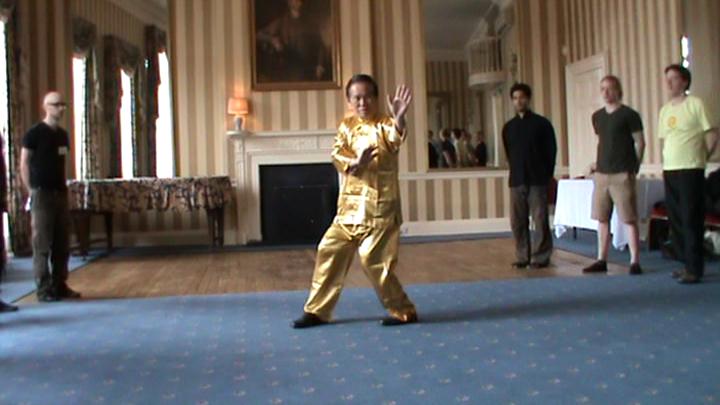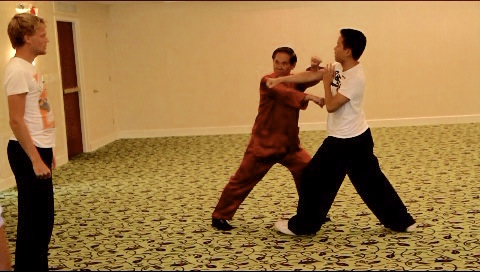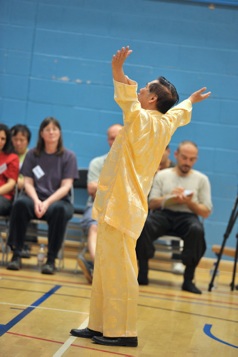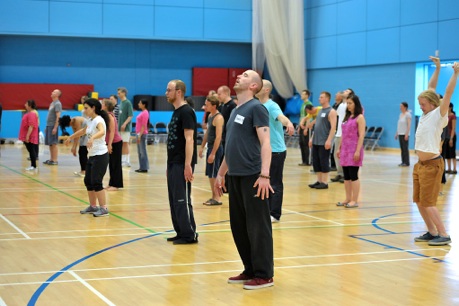SELECTION OF QUESTIONS AND ANSWERS
SEPTEMBER 2014 PART 2

An important discovery by Grandmaster Wong while preparing to teach Baguazhang is that a typical Baguazhang pattern has three planes
Question 1
Sifu indicated that Sifu had not learnt Baguazhang formally from any masters and studied Baguazhang from various sources including the internet. While there are many classics readily available today, there are closed secrets. How did Sifu get so many secrets?
— Sifu Zhang Wuji, Singapore
Answer
I learned the secrets of Baguazhang and Xingyiquan force training from the classics I have as well as from intuition. Because of my deep understanding of kungfu philosophy, when I read Bagauzhang and Xingyiquan secrets, even when they were stated arcanely, I could understand them very well. If there are missing parts, I would go into meditation, and the secrets would reveal themselves in my mind.
Question 2
I have always found it fascinating that Sifu often reveals secrets about Taijiquan (including combat applications) that I thought were known only to closed door disciples. Was it through mediation and direct teaching from the Cosmos, as well as extrapolation from Sifu's own rich experience? It was as if Sifu had taken a short-cut to bypass much of the trial and error some lineages went through.
Answer
Yes, I understood many of the Taijiquan secrets through meditation and direct teaching from the Cosmos as well as through extrapolation form my experience. Indeed, sometimes I also felt that I had taken a short-cut to bypass much of the trial and error some lineages went through.

An important secret concerning Taijiquan combat is revealed here
Question 3
Sifu mentioned that one of the insights that Sifu had when teaching Baguazhang was that a Baguazhang exponent had his hands, body and feet in different planes. I heard that if the hands and the waist are not in line, the connection is not there, such that it is difficult to transmit full power from the waist to the striking hands.
In Shaolin or Taijiquan attack patterns the feet, waist (dan tian) and hands face the opponent in one direction. How does Baguazhang address this issue of focusing the power of the feet, waist and hands at one single point of attack?
Answer
In my opinion, the way you have described how the feet, body and hands are aligned places a serious limitation to the practitioner. I would prefer the alignment follows the demand of the combat situation in question.
But for practice, we may allot three different planes for the feet, body and hands. If the feet are aligned towards north, the body will be pointing towards northwest, and the hands towards west.
As we continue the Circle Waling, we may change directions, mainly by rotating the waist, which is a positive transfer from Taijiquan. By the time we walk to the other side of the octagon, when the feet are aligned towards south, the body points towards southwest, and the hands point towards west, and the left and right hands would have changed positions while changing palms.
We may, if we like, rotate the waist further, so that the body points towards west and the hands point towards northwest while the feet still point towards south.
Because of our chi flow, whether there is connection if the hands and the waist are not in line, becomes irrelevant. The three harmonies of the feet, body or waist and hands can be in any planes, and it is still possible to transmit power from the waist or dan tian to the hands or any part of the body.
This applies not just to Baguazhang, but to any arts. For example you (and your wasit) may be facing north, but you can strike with power with your hands in any direction, including upwards and downwards.
Similarly, the issue of focusing the power of the feet, waist and hands at one single point of attack in Baguazhang, is irrelevant. In Baguazhang and any arts, the focusing of power can be at one or more points of attack.
While employing three planes is common in Baguazhang, there are also occasions when one or two planes are adopted. In "Open Window to Look at Moon", for example, the feet, body and hands are in one single plane, and the focusing of power is at this one point
Question 4
For "Dancing Butterfly", how is the co-ordination of breathing?
— Guilherme, Brazil
Answer
As you bend back and spread your arms, open your mouth wide and breathe out gently. Do not worry about breathing in.
Some people may wonder how could you just breathe out without breathing in? Would you be out of breath?
No, you won't be out of breath. Because you are relaxed, which is very important in practicing chi kung, energy from the Cosmos will spontaneously flow in after you have breathed out. But you need not consciously breathe in. Let the energy from the Cosmos flow in without you having to do anything.

Dancing Butterfly
Question 5
Can your qi gong exercise be done before or after gym workout? How long should one rest if it is after?
Answer
You can perform any other activities, including gym work, meditation, Tai Chi, yoga and making love, before or after the qigong practice, provided that these other activities are not harmful and you enjoy doing them.
You need not have to rest for any time to practice qigong after gym workout or any other activity.
It is not uncommon that some students in other schools are warned not to practice other types of qigong (chi kung), and not to take certain food or drinks like cake, sugar, ice-cream and coca cola, as these would affect their qigong benefit. That is their business, but our philosophy is different.
Our philosophy is that if a practitioner could enjoy other activities, like gym work, sex and delicious food, before without harm and with pleasure, he (or she) would be able to perform these activities better and have more enjoyment after he has started qigong.
Question 6
If Lifting the Sky is such a wonderful exercises, why are there so many chi kung exercises?
— Anne, England
Answer
Chi kung exercises usually developed to meet expedient needs. When practitioners lived at times and places different from where Lifting the Sky was practiced, a great variety of chi kung exercises resulted. Hence, today there are many other chi kung exercises.
In some places Lifting the Sky may not be available. So other chi kung exercises are practiced.
Different practitioners have different preferences and different choices. Some people may like to practice other exercises besides Lifting the Sky.
Although Lifting the Sky is wonderful, other chi kung exercises may have special benefits or special advantages. Those who wish to overcome illness, for example, may prefer Double Dragons which generates a more vigorous chi flow. Those who wish to develop internal force may prefer Golden Bridge or Three-Circle Stance. Hence there are many chi kung exercises besides Lifting the Sky.

It is important to keep the mouth gently open during chi kung practice
Question 7
Why must we keep our mouth open during chi kung practice?
Answer
During chi kung practice, energy flow in the body clears off a lot of toxic waste. This toxic waste is cleared off from the body through the mouth. If the mouth is not kept open, the toxic waste may float to the head causing blockage, dizziness and other unpleasant results.
Closing the mouth makes a person tensed. Keeping the mouth open helps him to be more relaxed. This can be readily verified.
The mouth is also a very important outlet to express emotions. When a person is sad, he cries or wails and lets out the negative emotion. When he is worried, he sighs. Good emotions are also expressed through the mouth. When a person is happy, he laughs or smiles. Closing the mouth will lock up the emotions.
Not many people realize that keeping the mouth open facilitates mental clarity. In other words, you think better when your mouth is open. You can try that out yourself. Think of a simple problem with your mouth close and with your mouth open. Find out which way you can think better.
Question 8
Can we be bare-footed when practicing chi kung?
Answer
It is better to wear shoes when practicing chi kung. Ground energy is not good for human, and if you don't wear shoes and practice on the floor or open ground, ground energy may seep into you and this can be harmful.
But if you practice above the ground, or with carpet covering the ground, you may practice bare-footed if you find it more comfortable.
This philosophy is different from New Age philosophy which recommends going about bare-footed so as to absorb earth energy. They call this being rooted.
In chi kung, being rooted is the reverse. It is energy flowing from a practitioner's body down into the ground. Energy flowing upward is floating.
It is unfortunate that many people in the West regard chi kung, or debased chi kung gymnastics, as New Age. Genuine chi kung is not New Age, it is very ancient.
Ground energy is not suitable for humans, who are built for cosmic energy. You feel pleasant when going up a mountain where cosmic energy is abundant. Going underground where ground energy is plentiful is unpleasant. Ground energy is suitable for other beings like ants, bats, snakes, ghosts and lower spirits.
In chi kung philosophy, ground energy is different from grain energy, which may be translated as earth energy in Western culture. We obtain grain energy from food. Plants change ground energy into grain energy which is good for us.
With good functioning of our heart and kidneys we use cosmic energy from heaven and grain energy from earth in the ration of 80-20 to make vital energy. In chi kung terminology, this process is described in an arcane manner as using fire and water, we transform heaven energy and earth energy into vital energy.
LINKS
Selected Reading
- Interesting Aspects of Baguazhang Discovered while Preparing to Teach It
- How Not to be Out of Breath After Hours of Sparring
- Lovely Faces
- Basic Counters against a Boxer's Jabs
- Five-Animal Play
